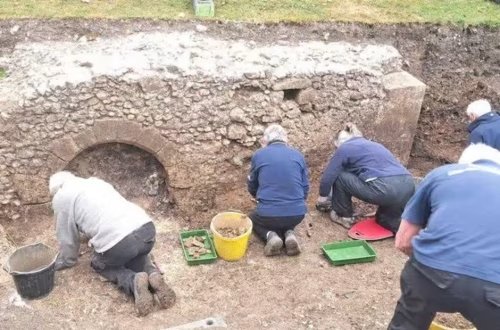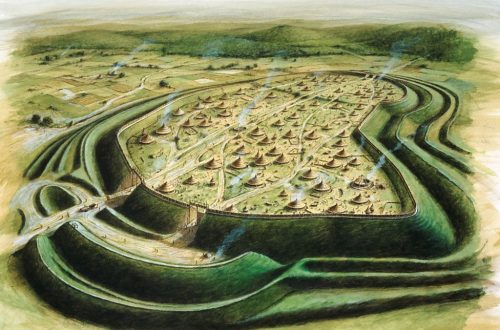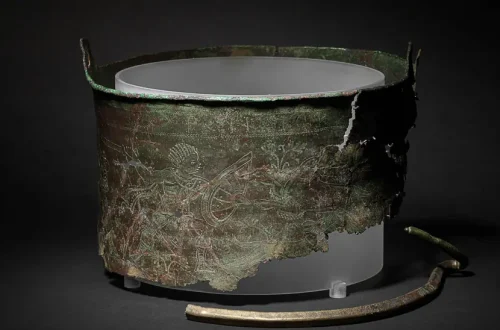In a remarkable find, researchers at Cambridge University Library have discovered fragments of a rare 13th-century manuscript containing medieval tales of Merlin and King Arthur. Hidden for centuries within the binding of a 16th-century ledger, these parchment fragments offer a fresh glimpse into the Arthurian legend, shedding light on its medieval French origins. Digitised through a groundbreaking three-year project, the manuscript is now accessible to scholars and the public, marking a significant moment in literary and historical research.
The manuscript fragments were found by an archivist examining the binding of a 16th-century estate register. The parchment, dating to around 1300, had been repurposed as a cover, a common practice in the early modern period when old manuscripts were recycled for bookbinding. The fragments contain episodes from the Old French Lancelot-Grail cycle, specifically the Estoire de Merlin, a 13th-century prose text detailing Merlin’s role in aiding King Arthur’s early court. The discovery, announced on 24 March 2025, is the only known surviving fragment of this particular medieval manuscript, making it a unique artefact of Arthurian literature (University of Cambridge, 2025).

The find includes accounts of the Battle of Cambénic and Merlin’s magical interventions, offering vivid details of the legendary wizard’s role in Arthur’s rise to power. Researchers used advanced imaging techniques, including multispectral analysis, to virtually “unwrap” the fragile parchment without damaging it, revealing text obscured for over 700 years (BBC, 2025).
The Estoire de Merlin is part of the broader Vulgate Cycle, a series of 13th-century French prose romances that shaped the Arthurian legend as we know it today. Unlike later English versions, such as Sir Thomas Malory’s Le Morte d’Arthur, the French texts emphasise Merlin’s prophetic and magical abilities, portraying him as a central figure in Arthur’s court. The Cambridge fragments, written in Old French, provide a rare snapshot of how these stories were told in medieval Europe, reflecting the cultural and literary tastes of the time (New York Times, 2025). The manuscript’s significance lies not only in its content but also in its rarity. Few manuscripts from the Lancelot-Grail cycle survive, and this fragment’s preservation within a ledger adds a layer of historical intrigue. According to Cambridge University researchers, the text differs slightly from other known versions of the Estoire de Merlin, offering potential insights into regional variations or scribal practices in 13th-century France (CNN, 2025).
The discovery was part of a three-year project funded by Cambridge Digital Humanities, aimed at digitising and analysing rare manuscripts in the university’s collection. The project employed cutting-edge technology to make the text legible, including high-resolution imaging and digital restoration. The digitised manuscript is now available on the Cambridge Digital Library, allowing global access for researchers, historians, and Arthurian enthusiasts (Cambridge Digital Humanities, 2025). The project also highlights the importance of revisiting archival collections. As noted by the University of Cambridge, many medieval manuscripts remain hidden in bindings or overlooked in library holdings, and discoveries like this underscore the value of meticulous archival work (University of Cambridge, 2025).
The find has generated widespread excitement, both academically and publicly. The New York Times described it as a “literary treasure,” emphasising the use of advanced technology to uncover the text (New York Times, 2025). CNN reported that the manuscript “brings Merlin’s medieval secrets to life,” capturing the public’s fascination with the Arthurian legend (CNN, 2025). Posts on X reflect similar enthusiasm, with users calling the discovery “fascinating” and praising the blend of historical research and modern technology. Scholars are particularly excited about the manuscript’s potential to deepen our understanding of the Lancelot-Grail cycle. The fragments may reveal new details about the transmission of Arthurian stories across medieval Europe, including how they were adapted for different audiences.
This is not the first time Arthurian fragments have been found in unexpected places. In 2019, researchers at the University of Bristol discovered similar Merlin manuscript fragments within a 16th-century bookbinding, highlighting a pattern of repurposed medieval texts (BBC, 2025). The Cambridge find builds on this trend, suggesting that many more Arthurian manuscripts may lie hidden in archives, waiting to be uncovered.
The discovery opens new avenues for studying the Arthurian legend, medieval French literature, and manuscript culture. Researchers plan to compare the Cambridge fragments with other Estoire de Merlin texts to identify unique features or variations. The digitised manuscript also allows global scholars to collaborate on translations and analyses, potentially reshaping our understanding of medieval storytelling (Cambridge Digital Humanities, 2025).
Sources:
- University of Cambridge, “Modern magic unlocks Merlin’s medieval secrets,” 24 March 2025 [https://www.cam.ac.uk/stories/merlin-manuscript-discovered-cambridge]
- BBC, “Lost manuscript of Merlin and King Arthur legend read for the first time,” 25 March 2025 [https://www.bbc.com/news/articles/c3e9k1v7p9wo]
- The New York Times, “Medieval Tales of Merlin and Arthur, Hidden for Centuries,” 28 March 2025 [https://www.nytimes.com/2025/03/28/arts/merlin-manuscript-cambridge.html]
- CNN, “Medieval tale of Merlin and King Arthur found hiding as a book cover,” 9 May 2025 [https://www.cnn.com/2025/05/09/style/merlin-manuscript-cambridge-discovery]
- Cambridge Digital Humanities, “CDH-funded digitisation of rare Merlin manuscript,” 27 March 2025 [https://www.cdh.cam.ac.uk/news/cdh-funded-digitisation-rare-merlin-manuscript]





